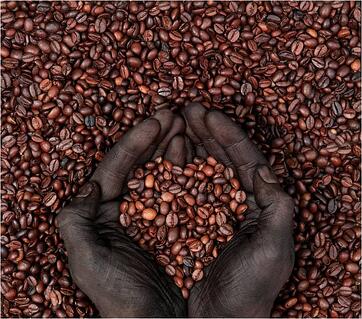It’s a popular legend. An Ethiopian shepherd boy notices the antics of his sheep after they graze among the fruit of the plant coffea arabica. But there’s more to the story. My wife, historian Melissa Vineyard enlightened me on how this initially obscure crop made its way from small-scale artisanal production to being the second most traded commodity in the world and the role international shipping played in that.
 When and how coffee leapt from Ethiopia across the Red Sea to the Arabian peninsula is not exactly known, but historians have traced the first commercial cultivation of coffee beans in the relatively dry, terraced gardens of Yemen on the southern coast of the Arabian peninsula.
When and how coffee leapt from Ethiopia across the Red Sea to the Arabian peninsula is not exactly known, but historians have traced the first commercial cultivation of coffee beans in the relatively dry, terraced gardens of Yemen on the southern coast of the Arabian peninsula.
Yemeni farmers grew the crop and took their harvest to trading centers along the coast, such as the city of Mokka–no, not just some chocolate coffee drink!–where the beans were shipped all over the Muslim world.
Coffee was first embraced in the Muslim world by Sufi mystics who used the drink to help them keep awake during meditation and the beverage spread throughout the Middle East and Northern Africa in both sacred and secular circles.
Muslims were the first to exploit the social drinking of coffee. Coffee houses represented one of the few legitimate public spaces for men to mingle since alcohol was taboo and restaurants were rare in the ancient and medieval Middle East.
Although raised in the U.S., the #1 coffee-consuming nation in the world, my wife shunned coffee herself until spending a year in the Middle East. Melissa steeled herself to gulp down the obligatory after-dinner coffee out of sheer politeness to her hosts, the beautiful, hospitable Druze neighbors living in the mountains of Northern Israel. To her surprise and delight, the dark, rich, sweet Turkish style coffee Melissa was served in potent little cups was nothing like the thin, bitter stuff slopped out by the waitresses at Denny’s.
Melissa was hooked and would take her new coffee habit home with her.
But how did this elixir get from ancient Asiatic shores and eventually to Melissa’s small coastal California town? International shipping!
Merchants shipped the coffee bean via small crafts north through the Red Sea and then by caravan overland to the shores of the eastern Mediterranean, further north to the Anatolian peninsula (modern Turkey), east to Northern Africa and throughout the Ottoman empire. Venetians, ever intrepid sea merchants, bought the beans from Arab traders in Eastern Mediterranean ports and shipped the beans in the cargo holds of their merchant vessels back to Venice and thence distributed coffee to the rest of Europe. Coffee’s cache was enhanced by Ottoman ambassadors serving the aristocrats of Europe elegant cups of Turkish style coffee just like the sultan enjoyed.
However, coffee was initially slow to catch on because of its high price. Grown in small batches and shipped internationally at great expense, it was out of reach for the masses. It wasn’t until coffee was grown as an alternative cash crop on the Caribbean island of Haiti that a cheaper, more abundant source of coffee beans was available.
The intense exchange of slaves and agricultural products like sugar and rum between the Caribbean and North and South America made coffee affordable for the many and not just the privileged few. Soon coffee, cheaper than tea imported from India via English merchants, became the stimulant of choice for North Americans. The tradition continues to this day.
 In short, the history of how the bean got from the slopes of East Africa to the new-washed shores of California is the extremely high volumes of ocean freight cargo and the much-lowered costs gained through slave labor of centuries past international shipping.
In short, the history of how the bean got from the slopes of East Africa to the new-washed shores of California is the extremely high volumes of ocean freight cargo and the much-lowered costs gained through slave labor of centuries past international shipping.
Next time you enjoy a cup of coffee, you can inform others of the role international shipping, supply and demand, and sadly, cheap (i.e. slave) labor were involved in the rise of java as an international beverage and an outstanding American favorite.
